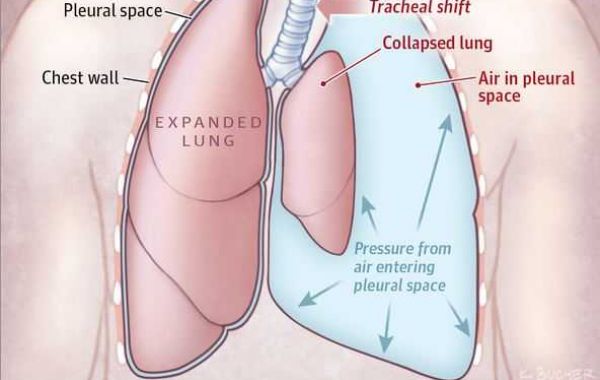Part 1 SCIENCE OF CHEST WOUNDS
Chest wounds can vary. There may be an entrance wound only (eg. impaled on a stick after falling from a tree) or both entry and exit wounds (eg. gunshot wounds to the chest). The science is the same. though treatment is slightly different and perhaps slightly less imperative. If a chest wound is not treated quickly death may be imminent as the lungs inflate but don't deflate, crushing the heart and collapsing one or both lungs with air pressure outside instead of inside the lungs. Let me explain:
Normal lungs inflate and deflate because they're contained inside individual sacs (pleura). There are no muscles attached to the lungs to inflate and deflate them. What happens is the muscle diaphragm contracts radially making the chest cavity larger by pulling down while the ribs rise with air inflation, essentially making the chest larger. Air then rushes into the lungs to equalize the pressure difference. It's kinda like a balloon inside another balloon when the outer balloon is expanded outward. Air pressure inflates the inner balloon. If you can't picture that, you'll have to just trust me on it.
Let's just talk about one lung for simplicity because if both pleura are punctured it's the same thing on both sides. Chest wounds puncture the sac surrounding one or both lungs inside the chest. When the system is punctured and exposed to open air NOT coming through the trachea, air rushes in through the new hole in the chest. Sometimes it's still OK because the air pushes back out with normal exhale ... although you'll definitely know something isn't right when you inhale because you can FEEL the colder air inside your chest. The point here is that both sides are still roughly OK and you'll have a little more time to take care of the situation by yourself if no one is around.
The problem comes when the air sucked into the chest cannot push back out because somehow the wound has formed a one way valve. It's not open but sealed itself behind each breath. When you inhale, air rushes in and then stays there, unable to push back out again. Take a few more breaths and the lung on that side is compressed, often so badly no air can come in when you breathe. That means now you're breathing with one lung and that's a fkn SCARY feeling. You're not exactly short of breath but you know you could be at any moment. Pressure from the air filled cavity on the puncture wound side can then actually push on your beating heart, and then push on the other GOOD lung. And if you thought you were scared a minute ago, now think panic.
NEXT: Part 2 TWO HOLE CHEST WOUNDS
--------------
Part 2 TWO HOLE CHEST WOUNDS
With wounds open on two sides, the problem is a little different. With no patent sac to help form a pressure gradient, the lung just lays there like a deflated balloon. If both holes are open on exhale, the air puffs out of both holes but then is sucked back in with normal breaths. Again, you get that 'cold air in my chest' feeling because the air isn't going through the nasal passages and cilia of the trachea that warm air as it passes through. But feeling cold air in your chest is the least of your problems when you're struggling just to breathe. THIS is why sucking chest wounds are so dangerous and need immediate attention. The main treatment is closing the wounds from open air, and the body gradually corrects internal pressures if the air already crowded in your chest is able to push out on exhale.

Another concern, altho less 'emergency status', is open wounds suck in bacteria, dust and smoke from the environment and tuck them around your warm, moist lungs, so remember even after you close the wounds, and your body reinflates its lungs, you're only half safe from serious complications. Infections are coming soon if your body can't fight them off by itself. But again, that's not your concern when you've fallen on a spike. Survival is the main concern. Just be aware emergency treatment won't be the end of it.
COMING UP:
Part 3 CHEST WOUNDS BUSHCRAFT (personalized)
--------------------
This post will make more sense if you start with Part 1 and Part 2
Part 3 CHEST WOUNDS BUSHCRAFT (personalized)
If I couldn't get authorized medical help, and I was by myself without hope of assistance, I would personally do something like what I'm about to describe. But I'm not a doctor and you decide for yourself what to do in remote situations. In any case, getting EMS is your best shot if available so I guess your cell phone is the next best thing to stopping a sucking chest on location.
The most primitive bandage is duct tape. Because it's not designed for medical use, the area around the wound will have to be dry so it will stick. I'd work my way to a sitting position (to squeeze out what I can of chest cavity air) and slap that tape on before I inhale. If there's an exit wound on my back, it's going to be a little more difficult to do it myself, though not impossible. I think the best plan is to make a VERY wide bandage of several strips, roll on my shirt to dry off the blood, and then lay on the tape, and hope for the best on the first try. I'm thinking the wider the duct tape strip, the more forgiving of error back there. The key is a clear head and not panicking while puffing. But I'll need to secure it there so it doesn't drop out my shirt walking back to camp. I'd lay out another LONG strip, and try to roll back to hit it dead center, and then pull the ends around to the front where I can see what I'm doing, to secure it in front. It will keep slipping but at least I'll have some leverage to keep it roughly in place in back.
Of course, duct tape is last ditch first aid, and cannot be a permanent solution. It tends to fall off with sweat, chest hair and blood like any adhesive. But this is the most crude way of treating a chest wound if there's nothing else around and I'm by myself.
Back in the civilized world, or the cabin, there are a number of bandages on the market for chest wounds, most involve padding and some kind of layer to block air and moisture with an excellent skin adhesive. If you don't have it, a regular gauze and that white cloth tape might do the trick. I remember having to wait for that white tape to fall off long after the wound was healed, the adhesive was so strong.
Just as a sidebar .... I once got the wind knocked out of me falling from a tree. Both lungs were not just out of air, they were glued shut with the sticky surface that makes oxygen/CO2 transfer possible. When my lungs finally inflated (and just moments seemed like forever) it was the strangest feeling I've known. It was like a combination of popping bubble wrap and ripping a cellulose sponge. It didn't hurt, but it was distressing. I mention this because it's what you're likely to feel when your lungs inflate after the chest wound is treated. You'll just be so grateful to breathe you won't care.









